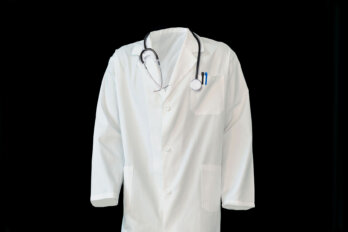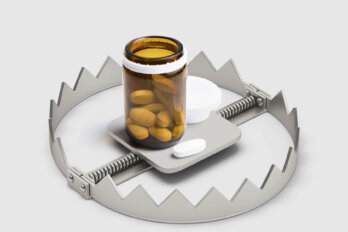In September 2010, Jennifer Arce, an experienced hairdresser based near San Diego, decided to try a new hair-straightening product manufactured by GIB LLC, commonly known as Brazilian Blowout. “I specifically chose Brazilian Blowout because it was advertised as the only hair-straightening treatment that improved the health of the hair, caused no damage, had no harsh chemicals and, most importantly, was formaldehyde free.” To get the hang of the product so that she could eventually use it on her clients, Arce arranged for her sister, also a coworker, to do a Brazilian Blowout on her.
Arce remembers the exact day, the exact moment, because her life hasn’t been the same since. “Within minutes of her applying it to my hair, my eyes were burning, my throat was burning, my lungs were burning, and I was having a hard time breathing. My symptoms were escalating, and my sister was having all the same issues.” Arce told me that even when the two women moved outside to complete the procedure in the fresh air, they continued to feel sick. That night when she went home, she was lethargic and could barely swallow, and she developed a terrible migraine. Her puzzled doctor attributed her ongoing problems to possible chemical poisoning. “In the days following the treatment, I was having a hard time doing little, simple, everyday tasks,” she said. “I couldn’t turn on a stove or an oven because the gas fumes coming out would make me sick. I couldn’t use any cleaning products. I couldn’t pump gas. I couldn’t use hairspray on myself or on my clients—just being at work around all these chemicals was a struggle.”
The penny finally dropped for Arce when she realized that some of her coworkers were getting sick too. “Many of them had been on and off antibiotics for months after exposure to the Brazilian Blowout chemicals, and we all had the same symptoms.” She and her sister started researching and discovered that an increasing number of people were recording similar complaints online. Moved to action, the US Occupational Safety and Health Administration began testing the product—including in Arce’s salon—and discovered that, far from being formaldehyde free, Brazilian Blowout contained up to 10 percent of this volatile, cancer-causing agent.
With GIB, the maker of the products, protesting all the while that they were safe, the state of California sued. Arce was one of the hairdressers involved in the action. While the public debate raged and the lawyers were on the case, she was back at work trying to make a living, having been forced to move salons when her previous boss refused to ban Brazilian Blowout in the shop. The allure of the product was too much. “Oh, yeah,” Arce said when I asked if the thing worked. “My hair never looked so good after using it. It was beautiful, shiny—you barely had to dry it. Some of the clients who do know it contains the chemical don’t care, because it’s making their hair so beautiful. And some of them will say, ‘Beauty costs!’”
After appearing on the Today show and other media, telling the story of her harrowing experience, Arce now gets letters from hairdressers across the country with similar heartbreaking tales. One of the things they commiserate about is the incredible ending to the story. GIB LLC was forced to pay a settlement of $600,000 to the state of California and “cease deceptive advertising that describes two of its popular products as formaldehyde-free and safe.” While GIB is now obliged to identify formaldehyde in its labelling and instructions, the US government lacks the power to force a product off the shelf if an obstreperous company is unwilling to do so voluntarily. Though it’s now banned in some countries, in the US, Brazilian Blowout has prevailed over its detractors and is still being used today in salons from coast to coast.
If you wanted a stark example of the abject failure of the US regulatory system to ensure the safety of personal-care products, Brazilian Blowout would surely be it. But the Brazilian Blowout case is not an isolated one, and this is perhaps not surprising, since the US law allegedly protecting Americans from being poisoned by their bathroom products dates back to 1938—well before the creation of many modern synthetic chemicals.
When I caught up with Lisa Archer, cofounder of the Campaign for Safe Cosmetics, I asked her how bad the current situation actually was. She’d rattled off a list of worrisome stories and statistics as long as my arm. “There are carcinogens in baby shampoo as well as phthalates and other problematic chemicals. Another example is mercury in skin-lightening creams, and there have actually been some cases of mercury poisoning from the use of these products.”
In addition to lacking the legal authority to require recalls of damaging products, current US (and Canadian) law allows companies to put dozens of secret ingredients in their products without disclosing them on the label. In a recent Canadian study, Environmental Defence tested personal-care products and discovered, on average, fourteen secret ingredients per product that were—quite legally—not disclosed on the ingredient lists. Archer points out the other reason that cosmetics safety is a concern in the US: “In a nutshell, FDA [Food and Drug Administration] is pathetically understaffed and underfunded. We’re talking about a budget of about $10 to 12 million per year and roughly ten full-time staff to govern a $60 billion cosmetics industry. There’s no way, given their current capacity and their current powers, that they could actually protect the public and ensure that cosmetics are safe.” Though there have been some victories at the state level (such as the California Safe Cosmetics Act that led to the prosecution of Brazilian Blowout), in the estimation of Ken Cook from the Environmental Working Group, which specializes in research and advocacy around toxic chemicals, prospects of significant further statutory gains in the United States are “very grim, unfortunately.”
Despite this, Cook and Archer were surprisingly upbeat regarding the pace of change in the United States. “There’s a sort of a ‘girlcott’ going on, versus boycott,” Archer told me. “Instead of opposing certain products, women are supporting companies who are more honest and transparent and using safer ingredients.” Though still making up less than 10 percent of industry sales in Europe and North America, natural and organic cosmetics were nonetheless worth $9.1 billion (US) in 2011. As of 2018, the US market alone was estimated at over $13.2 billion (US) and expected to continue to grow at roughly 7 percent a year.
“And it’s not just with cosmetics—you see it with BPA in baby bottles, you see organic food becoming more mainstream,” Archer continues. “Even if the policy change is going to take a long time to happen, people are waking up to this issue.”
It’s an indicator of how far so-called ethical consumerism has come that phthalates, surely the most unpronounceable word ever, became such a poster child for consumer concern. Though there are many toxic chemicals that informed consumers are now on the lookout for on the labels of their beauty products—including sodium lauryl sulphate, siloxanes, and quaternium-15—phthalates are top of the list.
If you want to talk phthalates, the go-to expert is, without a doubt, Shanna Swan from the Mount Sinai School of Medicine in New York. As we sat among the dog walkers and pigeons on a sunny day in Madison Square Park, the first question I asked was how the scientific literature had developed on phthalates over the past few years. What had we learned? “You know, it really depends on which phthalate you’re talking about,” she said. “Phthalates are a family of chemicals, and each one has a different toxicity, a different use, a different route of exposure.”
She proceeded to run down some of her analyses, and the first study she mentioned involved some unique test subjects. “We did some testing recently of phthalates in the urine of Old Order Mennonites—ten pregnant women,” she told me. “They had much lower levels of phthalates, BPA, and triclosan in their bodies than the average American. One of the main reasons for this, we think, is that they don’t use cosmetics. One woman had used hairspray, and she was the only one who had detectable levels of MEP [the breakdown product of DEP, a type of phthalate common in personal-care products].”
Another study that Swan mentioned—really the flip side of the Mennonite coin—is a startling look at phthalate levels in nail-salon workers. The levels of MBP (the breakdown product of the phthalate DBP) were significantly higher in manicurists after their work shifts. The use of gloves alleviated this problem, a fact that points to the nail products as the source of MBP. “Nail polish is bad, but perfume is the worst,” said Swan, referring to recent studies that demonstrated more uptake of phthalates from perfume than from any other personal-care product. In the study, women who used perfume had three times as much MEP in their urine as women who didn’t wear perfume.
Given that phthalates surround us every day, virtually every human being on the planet has the stuff coursing through their veins. And to further compound the creepiness, elevated phthalate levels have been found in breast milk and umbilical cord blood, meaning that moms aren’t just polluting themselves; they’re passing their phthalate pollution on to their fetuses and nursing babies. This is a problem because phthalates are hormone-disrupting chemicals. Once in our bodies, they are mistaken for estrogen and can create all the changes that estrogen achieves. Shanna Swan has long researched this phenomenon, including early publications about the possible role of phthalates in creating genital malformations in boys. A more recent study hints at neurobehavioural change resulting from exposure to phthalates. Another showed that elevated phthalate levels in expectant fathers can result in mutations in their sperm.
Hormones are like the traffic cops of our bodies. They tell everything—all critical processes—“Stop,” “Go,” or “Slow down.” No wonder hormone mimickers like phthalates have such dramatic effects. And when it comes to beauty products, phthalates are only the tip of a diverse and complicated toxic iceberg.
Another chemical that alert consumers are trying to avoid is parabens. Hormonally active chemicals that, like phthalates, mimic estrogen in the human body, parabens are added to countless consumer products—foods, pharmaceuticals, and beauty products, including antiperspirants and deodorants—as a preservative. Given their widespread use, it’s not surprising that they’re now found in the bodies of most people, including 95 percent of the American population. Though parabens have not been scientifically scrutinized nearly as much as phthalates have been, the examination of this preservative and its effects inside the human body is beginning to intensify.
If there is one researcher in the world who can claim to have brought parabens into the public eye, it’s Philippa Darbre of the University of Reading in England. In a widely cited 2004 study, Darbre and her colleagues found parabens in human breast tissue. “There was a bit of a furor,” Darbre told me over the phone from her laboratory. “Up to that point, it had been assumed that parabens, once they entered the human body, would be broken down by the liver. But something different altogether happens when they’re applied directly to the skin: the parabens bypass the liver and remain intact.”
Darbre told me she was struck by the way that breast cancers often develop. “Between 50 and 60 percent of breast cancers start in the upper outer quadrant of the breast, near the armpit.” To explain why this is completely disproportionate and striking, she gave me a crash course in breast anatomy. “The breast is divided into seven regions: four quadrants, a central region, a nipple area, and an axillary (or armpit) region. So, if breast cancer started equally across all areas of the breast, we would expect to see less than 20 percent of cancers originating in each of those regions. But we don’t, and 50 to 60 percent are up there in the upper, outer quadrant. Why? Is it because of all the chemicals being applied to that region?” This question has driven her to research the possible link between underarm products and breast cancer for over fifteen years.
To further her 2004 study, Darbre continued to look for parabens in sample breast tissue from radical mastectomies. This time, she used an even larger sample, and her suspicions were confirmed. “Not only did we repeat our 2004 results but we actually found even fourfold higher paraben levels in these samples.” More interesting (and worrisome) in its implications for human health was the significant difference in levels of one paraben chemical in different parts of the breast. “Propyl paraben did seem to have a gradient, with more found in the axilla region than in the inner regions, which you might expect is coming from the underarm.”
Do parabens cause breast cancer? As any cautious scientist would do, Darbre is quick to put her experimental results in context. “The fact that they’re in the breast doesn’t mean that there’s necessarily a relationship with breast cancer. It’s the first question. If they’re not getting into the breast, then they can’t have any effect on breast cancer.”
But even if they don’t cause cancer, there may be other effects. Although cancer is the main concern, it actually represents only about 5 percent of clinical abnormalities of the human breast, with benign conditions such as breast cysts being the most common.
In response to the many women writing to her and complaining about painful breast cysts, Darbre started looking into aluminum levels in breasts. Here again she found strong evidence linking antiperspirant use with disease. Aluminum is a common component of antiperspirants because it helps keep sweat off the wearer’s skin by blocking sweat ducts. Breast cysts also occur when sweat ducts don’t drain properly. Darbre has found strong evidence that, like parabens, aluminum levels are highest in the part of the breast near the armpit—also where a disproportionate amount of breast cysts are found—and that aluminum levels are higher in the fluid of breast cysts than in other parts of the body.
What’s the response of the chemical industry to Darbre’s work? Although the presence of parabens and aluminum in breast tissue is now undeniable, the US Food and Drug Administration continues to state on its website that “At this time, [the agency does] not have information showing that parabens as they are used in cosmetics have an effect on human health.”
Still, Darbre has tried to respond directly with further experimentation. Though manufacturers defend their particular parabens, the problem is not that there is one particular type of paraben in breast tissue, Darbre maintains; it’s the fact that there are many. Parabens are a family of chemicals, and it’s the effect of this potent and potentially toxic mixture that’s the worry. In a 2012 study, she took various parabens at the same concentrations she has measured in the human body and demonstrated that in combination they have an effect. “To my knowledge,” she told me, “this is the first science suggesting that parabens have the capability of turning a normal breast cell into a transformed breast cell.”
Scientists are producing a body of data that lead to some valid concerns about parabens. But on the flip side, where are the data supporting claims that parabens are safe? As Darbre put it, “Where are the data showing that if you put parabens into all these things that get into people at all levels…that there are no effects? There aren’t any such data. And my interpretation is that the current data imbalance is making companies nervous. Unfortunately, we are exposed to many chemicals each day that mimic estrogen and that have complementary action.”
In her own life, Darbre uses as few of these products as possible. And there is growing evidence that sweating is actually an important mechanism of the body’s detox system: the more you sweat, the more toxic chemicals you get rid of. Our over-air-conditioned, sweat-averse society’s antiperspirant habit reduces our body’s ability to clean itself while slathering on nasty pollutants. A toxic double whammy.
Not that long ago, the cosmetic industry’s knee-jerk solution to the problems of preserving your lipstick, shampoo, and shaving gel was always the same: “Add more parabens!” But there are now better ways to deal with the problem, and they include ingredients such as honeysuckle extract and thyme oil. Quite simply, sustainable cosmetics are more popular because products have become much better. Just how much better was sketched out for me by Judi Beerling, technical research manager for Ecovia Intelligence, a research and consulting company specializing in the organic sector.
After working for over thirty years in the conventional cosmetics industry, Judi decided that the formulation of conventional cosmetics had become “a bit stagnant, with everybody doing the same sorts of things over and over.” She now estimates that “85 to 90 percent of the ingredients and techniques [needed] to make sustainable cosmetics are now available, and this is increasing literally on a weekly basis. Now the challenge is to figure out how to combine them to get the best effect and to make the best cosmetics we can.”
Adapted from Slow Death by Rubber Duck: Fully Expanded and Updated by Rick Smith and Bruce Lourie. Copyright ©2019 Rick Smith and Bruce Lourie. Published by Alfred A. Knopf Canada, a division of Penguin Random House Canada Limited. Reproduced by arrangement with the Publisher. All rights reserved.





